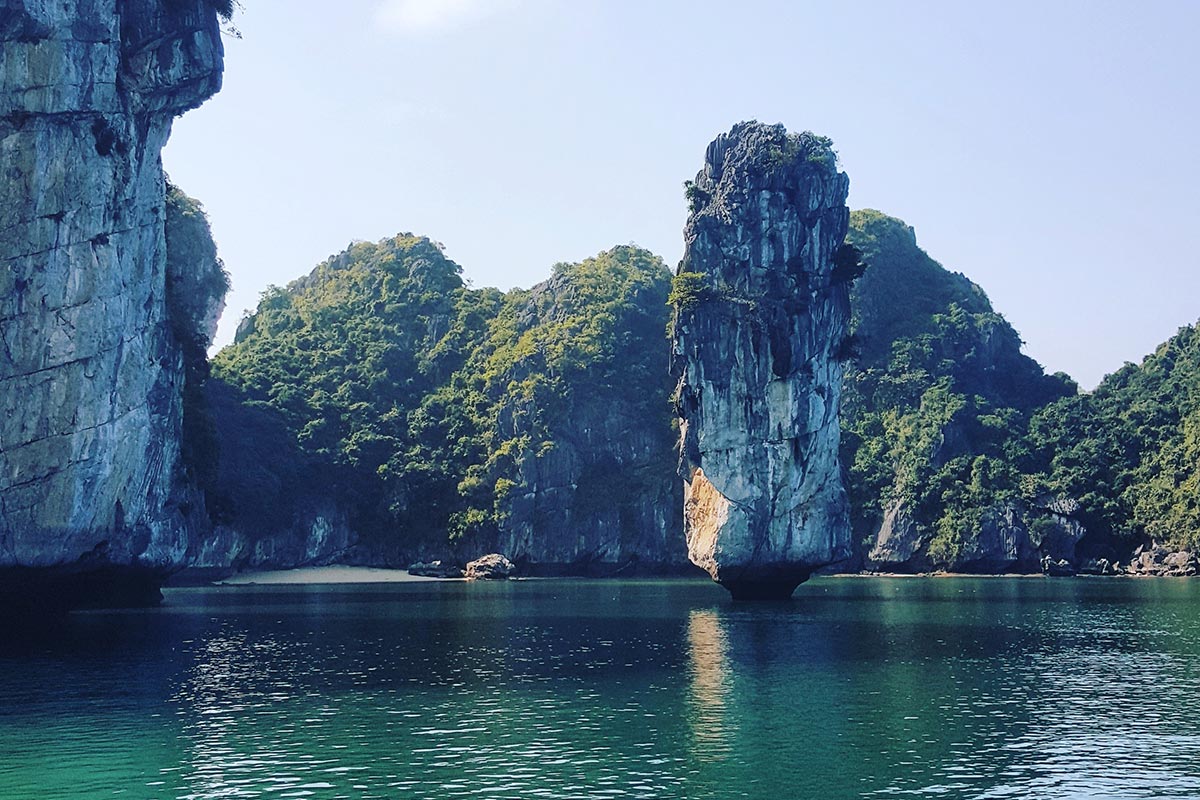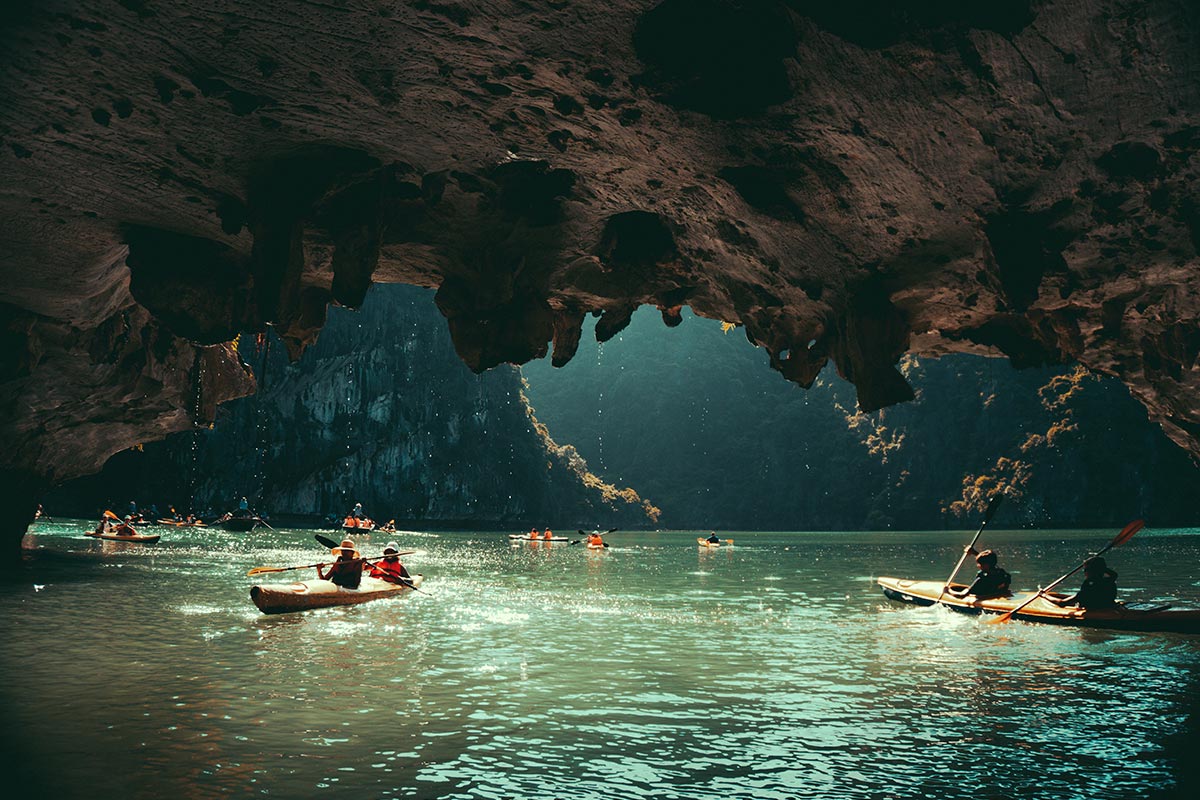In 1937, Mr. Vu Xuan Tao – a glass kiln worker – while digging sand to make raw materials for making glass, accidentally discovered a stone ax on Ngoc Vung island. This discovery caused a stir among French archaeologists at that time, initially identifying Ha Long as not only a natural wonder but also the cradle of prehistoric people.

There was a culture in Ha Long 3,500-5,000 years ago
Traces of prehistoric people
Ha Long Bay researcher Nguyen Thanh Si also kept the publication of the archaeologist Andecxen (Sweden) and the two sisters Colani (France). After many months of searching on the rocky islands of Ha Long Bay, they came to a common conclusion: “Stone tools, ceramic containers, stone and bone jewelry… have been discovered and collected.” in Ha Long all belong to the late Neolithic era – the era of prehistoric people.
French scientists have classified archaeological sites in Ha Long with similar characteristics into the concept of “Danhdola culture”. “Danhdola” is the name of Ngoc Vung island given by the French.
Later, when the North was liberated, Vietnamese scientists and Soviet archeology experts conducted many large-scale and large-scale explorations and surveys. A shocking discovery in the 1960s at the Tan Mai site – Ha Long Bay with fragments of gibbon man’s bones and the subsequent unearthing of bronze arrows from the Hung King period.
Scientists have confirmed: There was a Ha Long culture 3,500-5,000 years ago. Since the late Neolithic period, people have lived in Ha Long Bay. Traces of prehistoric people have been discovered at the sites of Hang Luon, Soi Nhu and Tien Ong… including stone objects and food remains. , prehistoric people identified the role of “marine economy” in human life thousands of years ago.

During the period of founding and defending the country, Ha Long Bay also played an important role in the country’s security and economic development. The book Dai Viet Complete History records: “Ky Ty, (Dai Dinh) in the 10th year (1149). In the spring, February, merchant ships from three countries, Trao Oa, Lo Lac, and Siam, entered Hai Dong port (Ha Long Bay) to apply for residence and trade, so they set up a site on the island, called Van Don, to buy and sell goods. Precious goods, offering local products”.
And Van Don commercial port was formed from there. According to Mr. Nguyen Thanh Si, the reason the Ly dynasty chose Van Don on Ha Long Bay as a trading port was because this area had many horizontal and vertical land and rock islands, dividing the sea into many deep and wind-tight pools and channels. Boats are safely anchored, not threatened by wind or storms.
In 1964, during an archaeological excavation at the ancient trading port of Van Don, archaeologists found Spanish coins minted in 1762, proving that they had passed through many border gates before arriving at Van Don, which is true. That shows that the trading scope of Van Don – Ha Long Bay commercial port at that time reached a number of Western European countries.
Sea wall
Head of the Ha Long Bay Management Board Ngo Hung said that based on documents kept at the Quang Ninh Museum, people came to Ha Long islands to reside and settle, not including the Stone Age people, as early as in the sixth century. People have lived crowdedly since the establishment and development of Van Don commercial port.
Of the 1,969 islands in Ha Long, only 40 are inhabited. These islands range in size from a few dozen to thousands of hectares and the inhabited islands are concentrated mainly in the east and southeast of Ha Long Bay. . In recent decades, many thousands of fishermen living on the water have begun to settle on some islands, turning pristine islands into prosperous ones such as Sa To (Ha Long City), Thang Loi Island (Van Don District). …
Unlike other sea areas in Vietnam that often have big waves and winds, Ha Long Bay with thousands of islands acts as a wall to prevent waves and big storms. With such conditions, the boat moves like in a pond or lake on land.
In other seas, fishing boats and ships are only for healthy men, but in Ha Long, boats are not only fishing vehicles but also their homes, places to eat, sleep and even worship ancestors. The fishermen on Ha Long Bay spend their whole lives attached to their boats from birth, growing up, getting married and until returning to eternity.
Pointing to the inside of the boat compartment, Mr. Nhat – a Ha Long fisherman – said that for generations, the boat of Ha Long fishermen has been the same, no matter how big or small, it has three compartments: the bow compartment, the middle compartment and the main compartment. after.
In particular, the middle compartment is the main compartment with a solid and fixed roof used to worship grandparents and is also the sleeping place for parents and small children. The nasal cavity is a place for fishing gear, casting nets and casting lines. The rear compartment (cockpit) usually has a roof, and is the sleeping place of unmarried adult children, and when they get married, both families must gather together to build a new boat for the young couple to have such a boat.
Over the past decade or so, some fishermen who are doing well have created a style of building houses on caged fish rafts, but most households still have a “house boat” as mentioned to make a living.
Photographer Do Kha was born and raised on Ha Long Bay. He said that nowadays most fishermen use boats equipped with marine engines and no longer use sails like before.
In 2003, the last sail of the family of Mr. Nguyen Van Tuan, a fisherman in Vong Vieng fishing village, was sold to a fisherman family on Ha Nam Island (Yen Hung). Since then, Ha Long Bay has been without sails. poetic brown sail.
Ms. Nguyen Thi Minh, a fisherman in Cua Van fishing village, said that today, the remaining traces of the ancient fishing village are the old love songs that are still passed down to this day, and almost all of the young men and women in the fishing village also belong to the singing of groups, sea chants and wedding songs.
Mr. Nguyen Van Cai, 96 years old, the oldest fisherman of Cua Van fishing village, is proud that Ha Long’s wedding singing is no less than the singing of Kinh Bac people. Mr. Cai said that Ha Long Bay’s weddings are also unique because according to custom, they are only held on full moon days, because this is when the bay has a bright moon, fish are scattered, and fishermen do not go fishing.
And on those moonlit nights, Ha Long beach is shimmering and magical. The groom’s boat comes to the bride’s boat to welcome the bride, instead of greetings and congratulations are cheerful songs and responses. Mr. Cai said that if the groom’s family sings “win”, then the bride’s family will “will” open the gate for their boat to hold the ancestral ceremony and welcome the bride. “Of course, the boy’s family always wins and the girl’s family always pretends to lose,” Mr. Cai smiled happily.
Source: Collector